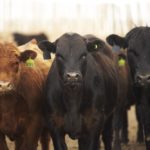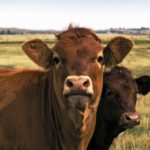Western Canadian feeder cattle markets traded $3-$5 above week-ago levels although lighter weight categories experienced week-over-week gains of $8 to as much as $12. The fed cattle market went through a correction, with live sales quoted from $181 to $186, down from the last week average trade of $195. This weaker live cattle trade appeared […] Read more

Klassen: Feeder cattle market remains firm

Klassen: Feeder cattle prices lukewarm on mixed factors
Western Canadian feeder cattle markets were steady to $2 higher compared to week-ago levels. All weight classes experienced lukewarm buying interest, despite improving margins in the feedlot sector. Most auction barns experienced minimal numbers; cow-calf producers are holding back on sales hoping for stronger values and extreme cold temperatures hindered cattle movement, especially in the […] Read more

Here’s how to assess the risk when bringing in calves
Beef 911: Mingling animals, transport times, light weights, and even weather can be factors that increase the risk of BRD
Reading Time: 4 minutes There are many factors to consider when bringing in calves to feed in order to minimize BRD (bovine respiratory disease), which is still the No. 1 cause of morbidity and often mortality in our feedlots. Knowing the history of the calves regarding weaning time, distance transported, vaccination, and health history — as well as upcoming […] Read more

Klassen: Feeder cattle resume upward trend
Western Canadian feeder cattle prices resumed the upward trend after a brief dip during the first major snowstorm of the year. Feeder cattle weighing above 750 lbs. traded $2-$4 above week-ago levels while calves were readily selling for $4 to as much as $8 higher. Optimism abounds in the feedlot sector, as Alberta fed cattle […] Read more

Klassen: Feeder market aggressively searches for demand
A boulder falling off a mountain accelerates and gains momentum as it nears the ground. Until we see another force come into play, there’s no signal the lows are near in the feeder complex. Once again, the western Canadian feeder cattle traded $8 to $10 below week-ago levels, with sharper declines noted on unweaned calves. […] Read more

Klassen: Patient buyers await lower feeder market
Patience is a virtue, the old saying goes. Unlike the past few years, feedlot operators have been rewarded for waiting and there is no clear signal the market has any incentive to deviate from the current direction. Western Canadian feeder markets were trading $5-$8 below week-ago levels as larger numbers come onstream in all weight […] Read more

Klassen: Feeder cattle market experiences mixed tone
Western Canadian feeder cattle markets experienced a diverse tone across the Prairies, with notable buying interest surfacing on yearlings. Compared to seven days earlier, prices for yearlings in southern Alberta were $5-$7 higher on average, as feedlots focused on purchasing local cattle. In southern Alberta, larger-frame lower-flesh black steers weighing 900 lbs. were quoted at […] Read more

Four keys to successful calf preconditioning
Veterinarian Mark Hilton shared his experiences working with an Indiana producer who co-operated with Purdue University on a preconditioning project from 1999 through 2009. When they boiled it down, four points came to the forefront as keys to success that could be transferred to other farms.

April U.S. cattle placed in feedlots at three-year high
Chicago | Reuters –– The number of cattle placed into U.S. feedlots in April jumped seven per cent from a year earlier, according to a government report on Friday, far exceeding most analysts’ forecasts. Feedlots were still operating at a loss, analysts said. But lower prices for young calves allowed feedlots to buy more of[...]
Read more
Read more

Thin cows will cost you money
Reading Time: 2 minutes Dry conditions have dramatically reduced forage growth — and that increases the value of a feeding management program. “Getting the cow through summer in good body condition and maintaining calf growth rates is the first step,” said provincial beef and forage specialist Barry Yaremcio. “Nutritional requirements of a lactating cow are 25 per cent higher[...]
Read more
Read more

